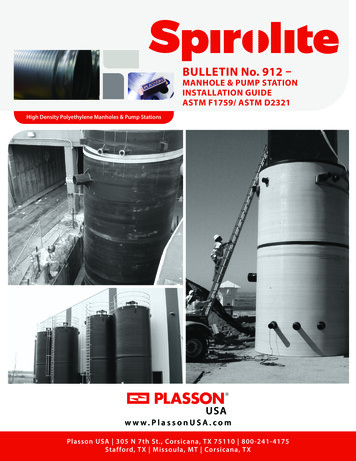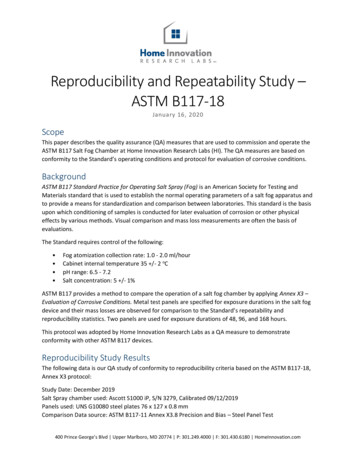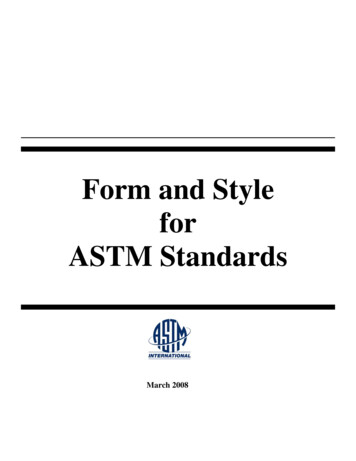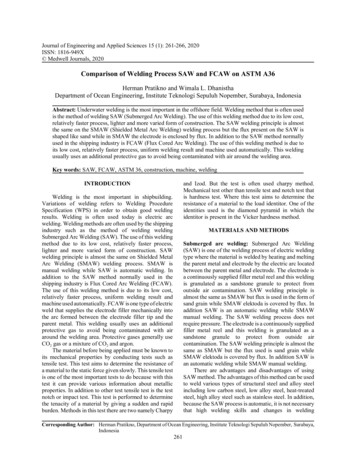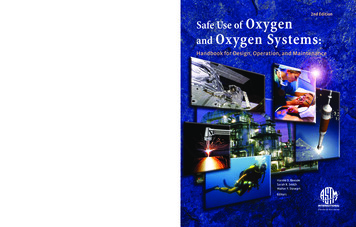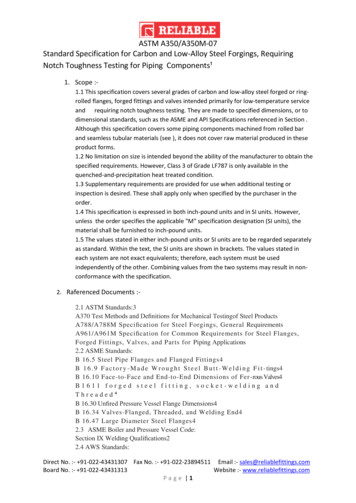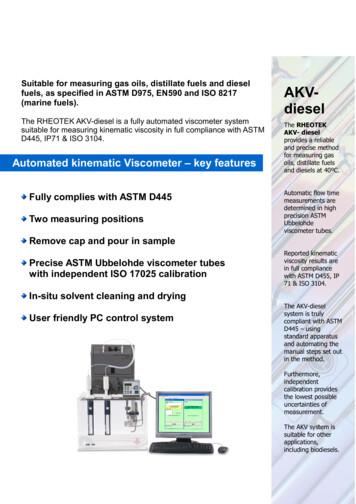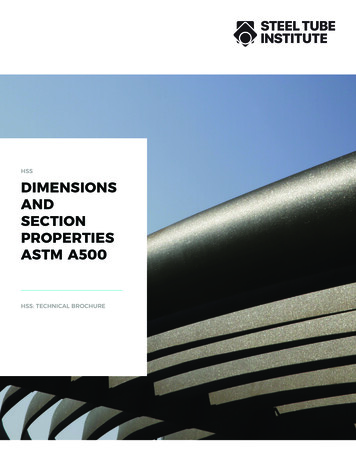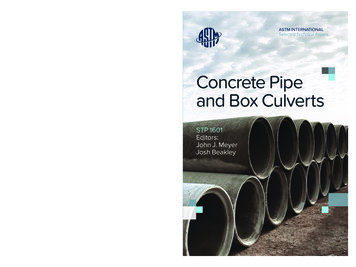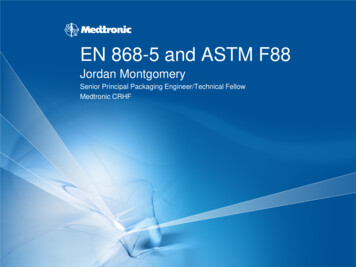
Transcription
EN 868-5 and ASTM F88Jordan MontgomerySenior Principal Packaging Engineer/Technical FellowMedtronic CRHF
Highlights AcknowledgmentsRequirementsTest MethodsDisconnectInitial Comparison Study– Study Design– Results– Analysis ASTM Work Item
Acknowledgements Sameer UpadhyayaSalin YousefniaMark RalphJim Domke
Sterile Barrier System Requirements ISO 11607-1– Clause 5.1.8 c) Materials shall demonstrate minimum specifiedseal strength when a seal is formed with another specifiedmaterial under specified conditions.– Clause 5.1.9 b) If formed by sealing, the specified requirementsfor seal width and seal strength (tensile and/or burst) shall bemet.
Seal Strength Test Methods ISO 11607-1, Annex B– Seal Strength ASTM F88 – Standard test method for seal strength of flexiblebarrier materials ASTM F1140 – Standard test method for failure resistance ofunrestrained and non rigid packages for medical applications ASTM F2054 – Standard test method for burst testing of flexiblepackage seals using internal air pressurization within restrainingplates EN 868-5:1999, Annex D – Packaging materials and systems formedical devices which are to be sterilized – Part 5 Heat and selfsealable pouches and reels of paper and plastic film construction –Requirements and test methodsAs listed in 11607-1
Seal Strength Test Methods ISO 11607-1, Annex B– Seal Strength ASTM F88 – Standard test method for seal strength of flexiblebarrier materials ASTM F1140 – Standard test method for failure resistance ofunrestrained and non rigid packages for medical applications ASTM 2054 – Standard test method for burst testing of flexiblepackage seals using internal air pressurization within restrainingplates EN 868-5:1999, Annex D – Packaging materials and systems formedical devices which are to be sterilized – Part 5 Heat and selfsealable pouches and reels of paper and plastic film construction –Requirements and test methodsAs listed in 11607-1
DisconnectUnited StatesEuropeFDANotified BodyConsensusStandardsHarmonizedStandardsISO 11607-1EN ISO 11607-1ASTM F88EN 868-5: Annex DState of the Art
EN 868-5 A closer look Particular requirements of clause 4.2 and 4.5 can beused to demonstrate compliance with one or more butnot all requirements of EN ISO 11607-1. 4.2 – Materials– 4.2.1 Porous material– 4.2.2 Plastic film 4.5 - Performance requirements and test methodsScope: limited to pouches and reels.
EN 868-5 A closer look 4.5 - Performance requirements and test methods– 4.5.1 When tested in accordance with the method described inAnnex D the strength of the seal joint shall not be less thanrequired for the intended purpose, both before and after beingsubjected to the sterilization process. Requirement (Healthcare facility for steam) 1.5N / 15mm Requirement (all other sterilization) 1.2N / 15 mm NOTE 2: For applications outside of healthcare facilities,requirements are given in EN ISO 11607-1.– 4.5.2 The seal shall be continuous and cover the specified width.There shall be no disruption of the surface of the porous materialadjacent to the seal lines upon opening. Compliance shall betested in accordance with Annex E.
EN 868-5 - Annex D (normative)Method for the determination of the strength of theseal joint for pouches and reel material Units: N / 15mmPrincipal: strips cut at 90 through seals (right angles)Preparation: 15 0.1 mmProcedure: rate of separation 200 10 mm / minuteReport:–––––Record max strength in N / 15mm widthSupported/unsupported, specs, data sheetsElectronic device frequency rateIdentification of the product under test, test house, dateNumber of the standard used for the test.15mm – 8”/minute
ASTM F88 – A closer look Current designation: F88/F88M-09– Title: Standard Test Method for Seal Strength of FlexibleBarrier Materials Scope:– Measurement of seal strength between flexible materials– May be used on seals between a flexible material and arigid material– Measure the force required to separate the test strip ofmaterial containing the seal as well as the mode ofspecimen failure.
ASTM F88 – A closer look Significance and Use– Discusses minimum and maximum seal strength, butdoes not have a required value.– Discusses maximum force and average force– Discusses / provides basic guidance on techniques andconsistent use of a technique
ASTM F88 – A closer look Procedure:– Calibrated tensile tester– Sample prep, perpendicular to the seal, width 1 inch(also calls out 0.984, and 0.591) (0.591 15mm)– Sealed area approximately equidistant between the grips– Center the test strip laterally in the grips– Detail any technique used to control tail orientation– Rate of separation 8 to 12 inches /minute– Record maximum force and mode of failure– If the strip peels apart in the seal area, average forcemay be important– Plot of force vs. grip travel is useful– Caution on the effect of other failure modes (elongation,break, delamination)
Comparison Summary (F88 and EN 868-5) Add comparison summary tableEN 868-5ASTM F88Test Strip Width15mm (0.591”)1”, 0.984”, 0.591”Rate ofSeparation200 lexibleFlexible,flexible/rigidTechniqueReport supportedor unsupportedA, B or C
Comparison Study A small study was conducted to form a baselinefor comparison between the methods. Key variables for comparison chosen:– Test strip width (1 inch vs. 15mm)– Rate of Separation (8 inches / minute versus 12 inchesper minute)
Comparison Study Design One material used throughout– Porous web: Tyvek 1073Bcoated with CR-27– Film: 36603-S, 5 mil nylonlaminated All test strips came fromone lot of pouches All test strips cut fromapproximately the samelocation.
Comparison Study Design All samples prepped in 1 lab, by 1 personSamples were not subjected to sterilizationSample size of 15 used for each group3 labs4 groups per labUnsupported tailMaximum force recorded in lbs / width
Comparison Study DesignTest GroupLabSample WidthRate of SeparationSample SizeACRDM1 inch8 inch / min15BCV1 inch8 inch / min15CNeuromodulation1 inch8 inch / min15DCRDM1 inch12 inch / min15ECV1 inch12 inch / min15FNeuromodulation1 inch12 inch / min15GCRDM15mm8 inch / min15HCV15mm8 inch / min15INeuromodulation15mm8 inch / min15JCRDM15mm12 inch / min15KCV15mm12 inch / min15LNeuromodulation15mm12 inch / min15
Results – Pooled Data (n 45)Test (width – speed)Average* (lbs / width) Standard Deviation1” – 8”/minute1.160.131” – 12”/minute1.140.1015mm – 8”/minute0.690.0615mm – 12”/minute0.680.07* Average of the peak values
Results – Pooled Data (n 45)Test (width – speed)Average* (N / 15mm)Standard Deviation1” – 8”/minute3.050.351” – 12”/minute3.000.2715mm – 8”/minute3.070.2815mm – 12”/minute3.030.32* Average of the peak valuesConversion of lbs/inch width to N / 15mm:Conversion of lbs/15mm width to N / 15mm:1 inch 25.4 mm
Boxplot of the results
Boxplot of the results – with spec limits used for y-axis Spec limits: 0.5 lbs/in – 6.0 lbs/in 1.3 N/15mm – 15.8 N/15mm
ANOVA – Pooled Data (n 45)
Comparison of test strip width1 inch and 15 mm test strips @ 8” / minute
Comparison of test strip width1 inch and 15 mm test strips @ 12” / minute
Comparison of test speed,8”/minute vs. 12”/minute with 1” width test strips
Comparison of test speed,8”/minute vs. 12”/minute with 15mm width test strips
Preliminary Findings No significant difference between test speeds. No significant difference between test strip widthswhen the data is converted to equivalent units. No significant difference in results between thelabs participating.
Observation: Relationship between test stripwidth ratio and ratio of the resultsASTM F88: 1 inch 25.4mmEN 868-5: 15mm
Preliminary Findings No significant difference between test speeds. No significant difference between test strip widthswhen the data is converted to equivalent units. No significant difference in results between thelabs participating. Ratio of test strip width provides a means ofcorrelating the result to the alternate method.
ASTM Work Item – WK46566 The purpose of this work item is to conduct a studythat establishes, with empirical data, a correlationbetween the result of a seal strength testconducted per the process described in ASTM F88using a test strip width of 1 inch to the result of thesame test conducted using a 15 millimeter (mm)test strip width.
Proposed Study Design:Flexible pouches: adhesive coated (Kirkland) uncoated (Signature) 2 techniques (A, C), 9 labs Multiple labs to show results are consistent regardless of lab / test equipment / operator. Show the correlation between widths regardless of technique. Uncoated / adhesive coated shows correlation between widths is independent of material. Plan is collect peak seal strength. Could reduce # of samples, I’m open to ideas.Sample Preparation:Samples will be prepared with a goal of limiting variability from various sealing parameters, materialsources, package designs, etc. All uncoated samples will be supplied by X. Samples for each width will be cut from 1 rail seal by X. All adhesive coated samples will be supplied by X.Technique A15mm1 InchLab 1Lab 2Lab 3Lab 4Lab 5Lab 6Lab 7Lab 8Lab 9Kirkland GroupTechnique CTechnique A15mm1 Inch15mm1 InchTechnique C15mm 1 Inch
Work Item MembersCompanyNameEmail addressCardinal HealthOndrea rds Lifesciences LLCVikas Patelvikas patel@edwards.comRollprint Packaging Products, Inc.Henk BlomHblom@rollprint.comNelson LaboratoriesRobert Haleyrhaley@nelsonlabs.comDSMMichael GrimmMichael.grimm@dsm.comDDL, Inc.Patrick NolanPatrick.Nolan@testedandproven.comMedtronic CRDMJordan Montgomeryjordan.montgomery@medtronic.comMedtronic CardioVascularSameer Upadhyayasameer.upadhyaya@medtronic.comBeacon Converters, Inc.Marie Tkacikmarie@beaconconverters.com
Thank You!
ASTM F88 – Standard test method for seal strength of flexible barrier materials ASTM F1140 – Standard test method for failure resistance of unrestrained and non rigid packages for medical applications ASTM 2054 – Standard test method for burst testing of flexible package seals using internal air pressurization within restraining plates EN 868-5:1999, Annex D – Packaging .


